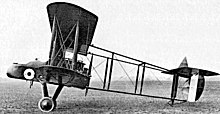Configurazione spingente
Da Wikipedia, l'enciclopedia libera.

In un mezzo di trasporto, il cui moto è assicurato dai principi espressi dal terzo principio della dinamica, è definita configurazione spingente quella in cui l'elica (o più eliche) si trovi dietro il rispettivo motore. Secondo lo storico dell'aviazione Bill Gunston, una pusher propeller, ovvero un'elica in configurazione spingente, è quella montata dietro al motore in modo che l'albero di trasmissione del moto sia in condizioni di compressione.[1] Con il termine si definisce anche comunemente la specifica impostazione di un aereo ad ala fissa quando il gruppo (o più gruppi) motoelica ha una configurazione spingente.
La configurazione spingente descrive questo specifico dispositivo di spinta (elica o ventola intubata) connesso ad un mezzo di trasporto, applicato sia a aerostati (dirigibile), aerodine (aereo, ekranoplano, paramotore, velivolo ad ala rotante) o altri tipi, come hovercraft, airboat e motoslitte ad elica o aeroslitte.[2] Veicoli e velivoli sono stati progettati e costruiti in numerose e diverse impostazioni generali, alcune delle quali in modo piuttosto radicale tanto che le definizioni iniziali non sono più applicabili, ad esempio il motoaliante Radab Windex, l'idrovolante Seawind 300C, l'ekranoplano anfibio Alekseev A-90 Orlyonok ed il motoaliante a propulsione elettrica e-Genius GFC 2011.
Note
[modifica | modifica wikitesto]- ^ Gunston, Bill, The Cambridge Aerospace Dictionary Cambridge, Cambridge University Press 2004, ISBN 0-521-84140-2.
- ^ The Propellor-Driven Sleigh (archiviato dall'url originale il 10 luglio 2011).
Bibliografia
[modifica | modifica wikitesto]- (EN) Jon Guttman, Harry Dempsey, Pusher Aces of World War 1, Osprey Pub Co, 2009, ISBN 978-1-84603-417-6.
- (EN) Bruce Carmichael, Personal Aircraft Drag Reduction - Propeller behind tail - pros and cons.
- (EN) Daniel P. Raymer, Aircraft Design: A Conceptual Approach, AIAA Education Series.
- (EN) Malcom J. Abzug, E. Eugene Larrabee, Airplane Stability and Control, Cambridge University Press, 2005.
- (EN) Darrol Stinton, The Design of the Aeroplane, BSP Professional Books, 1993.
- (EN) Sighard F. Hoerner, Fluid-Dynamic Lift: Practical Information on Aerodynamic and Hydrodynamic Lift, 2ª ed., Hoerner Fluid Dynamics, 1992, ISBN 9998831636.
Voci correlate
[modifica | modifica wikitesto]- Configurazione traente-spingente
- Configurazione traente
- Elica intubata
- Ventola intubata
Altri progetti
[modifica | modifica wikitesto] Wikimedia Commons contiene immagini o altri file su configurazione spingente
Wikimedia Commons contiene immagini o altri file su configurazione spingente
Text is available under the CC BY-SA 4.0 license; additional terms may apply.
Images, videos and audio are available under their respective licenses.
